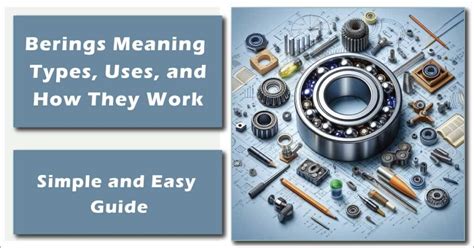A Comprehensive Guide to Bearings: Definition, Types, Applications, and Maintenance
Introduction
Bearings are mechanical components that enable the smooth and efficient rotation of shafts or axles. They play a pivotal role in various industries, including automotive, aerospace, manufacturing, and construction. This article aims to provide a comprehensive understanding of bearings, encompassing their definition, classification, applications, and effective maintenance practices.
What is a Bearing?
Definition: A bearing is a mechanical device that supports and guides a rotating shaft or axle, minimizing friction and wear. It consists of two or more bearing elements that roll or slide against each other, allowing relative movement while maintaining alignment and stability.
Importance: Bearings are crucial for the proper functioning of machinery. They reduce friction, prevent wear and tear, and ensure the efficient transmission of power. According to the American Bearing Manufacturers Association (ABMA), bearings account for approximately 80% of all mechanical failures.
Types of Bearings
Bearings are classified into various types based on their design, construction, and operating principles:

Rolling Element Bearings
-
Ball Bearings: Use spherical balls as rolling elements, offering high load capacity and low friction.
-
Roller Bearings: Employ cylindrical or tapered rollers as rolling elements, suitable for high axial or radial loads.
-
Needle Bearings: Utilize thin, needle-shaped rollers, providing compact designs and high load-carrying capacities.
Plain Bearings
-
Journal Bearings: Consist of a shaft rotating within a bearing shell, relying on a thin film of lubricant for low friction.
-
Thrust Bearings: Designed to handle axial loads, with flat or tapered surfaces sliding against each other.
Other Types
-
Magnetic Bearings: Use magnetic fields to levitate and control the shaft, enabling ultra-high speeds and precision.
-
Fluid Film Bearings: Employ pressurized fluids to create a lubricating film, ensuring smooth operation at high loads.
Applications of Bearings
Bearings are used in a wide range of applications across industries:
-
Automotive: Engines, transmissions, wheels, suspensions
-
Aerospace: Jet engines, landing gears, control systems
-
Industrial Machinery: Pumps, compressors, conveyors, machine tools
-
Medical Equipment: Imaging systems, surgical robots, dental drills
-
Construction Equipment: Cranes, excavators, forklifts
Bearing Selection and Design Considerations
Choosing the appropriate bearing for a specific application requires careful consideration of various factors:


-
Load Capacity: The bearing must handle the expected loads, both radial and axial.
-
Speed: The operating speed of the shaft affects the bearing's lubrication and heat dissipation.
-
Environment: Bearings must be compatible with operating conditions, such as temperature, humidity, and chemical exposure.
-
Accuracy and Precision: The required precision and accuracy of the shaft's rotation determine the bearing type and tolerance.
Effective Bearing Maintenance
Proper maintenance is crucial to ensure maximum bearing life and performance:
-
Lubrication: Bearings require adequate lubrication to minimize friction and wear.
-
Monitoring: Regular monitoring of temperature, vibration, and noise can detect potential bearing issues.
-
Inspection: Periodic inspections allow for early detection of damage or wear.
-
Replacement: Bearings should be replaced when they reach the end of their useful life to prevent catastrophic failures.
Strategies for Extending Bearing Life
-
Proper Lubrication: Ensure regular lubrication using the appropriate lubricant and method.
-
Load Management: Avoid overloading bearings and distribute loads evenly.
-
Environmental Control: Protect bearings from excessive heat, moisture, and contamination.
-
Condition Monitoring: Regularly monitor bearings to identify and address potential issues early.
-
Proper Storage and Handling: Store bearings in a clean, dry environment and handle them with care.
Tips and Tricks for Bearing Installation and Maintenance
- Use the appropriate tools and techniques for bearing installation and removal.
- Clean and lubricate bearings before installation.
- Check bearing alignment and clearances according to manufacturer specifications.
- Monitor bearing temperature and vibration to detect potential problems.
- Keep records of bearing maintenance and replacement history.
Step-by-Step Approach to Bearing Maintenance
1. Inspection:
- Visually inspect bearings for damage, wear, or contamination.
- Check lubricant levels and condition.
- Measure bearing clearances and alignment.
2. Disassembly:
- Disconnect power source and secure rotating parts.
- Remove bearing covers or housings.
- Carefully disassemble bearings and inspect components.
3. Cleaning:

- Remove old lubricant and contaminants using an appropriate cleaning agent.
- Rinse bearings thoroughly and dry them completely.
4. Lubrication:
- Apply the specified lubricant to all bearing surfaces.
- Ensure proper lubrication methods and intervals.
5. Assembly:
- Position bearings correctly and adjust clearances.
- Reassemble bearing covers or housings.
- Reconnect power source and test for proper operation.
Tables
Table 1: Types of Bearings and Their Characteristics
| Bearing Type |
Rolling Elements |
Advantages |
Disadvantages |
| Ball Bearing |
Spheres |
Low friction, high load capacity, compact |
Sensitive to misalignment, limited axial load capacity |
| Roller Bearing |
Cylinders or tapers |
High axial and radial load capacity, rugged |
Higher friction, larger size |
| Needle Bearing |
Thin needles |
Compact, high load-carrying capacity |
Sensitive to misalignment, limited speed |
| Plain Bearing |
Sliding surfaces |
Low friction at low speeds, simple design |
Requires constant lubrication, higher wear |
Table 2: Bearing Applications across Industries
| Industry |
Applications |
Bearing Types |
| Automotive |
Engines, transmissions, wheels |
Ball bearings, roller bearings |
| Aerospace |
Jet engines, landing gears |
Roller bearings, magnetic bearings |
| Medical |
Imaging systems, dental drills |
Ball bearings, plain bearings |
| Industrial |
Pumps, machine tools |
Roller bearings, thrust bearings |
| Construction |
Cranes, excavators |
Roller bearings, plain bearings |
Table 3: Common Bearing Failure Modes and Causes
| Failure Mode |
Causes |
Symptoms |
| Wear |
Abrasion, corrosion, lubrication issues |
Increased friction, noise, vibration |
| Fatigue |
Excessive loads, misalignment |
Cracks, spalling, loss of rigidity |
| Contamination |
Dirt, moisture, debris |
Lubricant degradation, wear |
| Misalignment |
Incorrect installation, shaft bending |
Premature wear, noise, vibration |
| Lubrication Failure |
Insufficient or improper lubrication |
Increased friction, heat, seizure |

